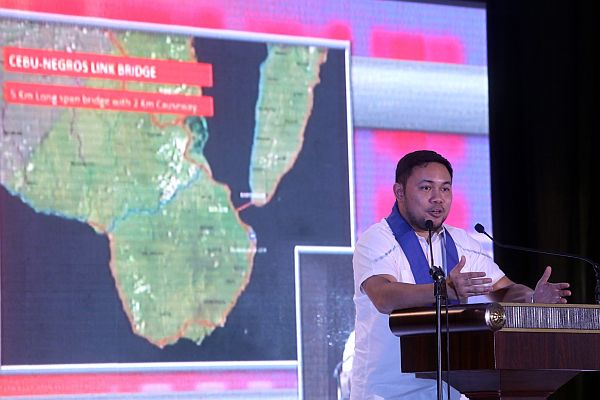
Public Works and Highways Secretary Mark Villar discusses one of the planned bridges for Cebu – the 7 km Cebu-Negros bridge in Santander town in southern Cebu and Sibulan in Negros Oriental – included in the P458-billion Philippine Inter-Island Linkage Project of the government’s “Build, Build, Build” initiative. Villar was one of the speakers of the Business Summit last Thursday, one of the activities in the Mandaue Business Month 2017.
CDN PHOTO/TONEE DESPOJO
OPPORTUNITIES in ‘infra’s golden age’
Developers are encouraged to zero in on the thriving opportunities outside the country’s capital as the government ushers in a “golden age of infrastructure” through its ambitious “Build, Build, Build” program.
Property management and research firm Colliers Philippines said much of the country’s growth will hinge on ramped-up infrastructure spending, which should support the Duterte administration’s commitment to build crucial projects across the country.
“The ushering in of the ‘golden age of infrastructure’ also lends support to the government’s decentralization push which should unlock land values in areas outside of Metro Manila and stimulate business activities in the countryside,” Colliers said in a statement.
Under its massive “Build, Build, Build” initiative, the government planned to spend over P1 trillion for infrastructure projects next year and a total of up to P9 trillion until 2022.
One of the projects for Cebu included in the program is the P50-billion 74-kilometer Metro Cebu Expressway, which the Department of Public Works and Highways (DPWH) is set to start work on by next year.
Linkage projects
Also in the pipeline is the P458-billion Philippine Inter-Island Linkage Project, which includes the construction of a fourth bridge that would link Lapu-Lapu City to mainland Cebu.
This is a 420-meter bridge that the national government plans to build near the Cansaga Bay area in Consolacion town to Pusok, Lapu-Lapu City.
At the same time, the third Cebu project, which is the P27.9-billion Cebu-Cordova Link Expressway, is also moving forward with the scheduled awarding of contract among two foreign contractors expected to happen this month.
Airport expansion
Cebu’s airport expansion project is also projected to be completed mid-2018 and that it should further enhance the province’s travel and tourism competitiveness, Colliers pointed out.
Colliers said they see the country sustaining robust growth on the back of the government’s infrastructure and decentralization push.
Among the key economic segments that will benefit from the government’s thrust is property development, the firm said.
“Infrastructure implementation coupled with decentralization should spur the growth of office, residential, retail, industrial, and hotel & leisure segments,” Colliers added.
Expand in provinces
Given the current administration’s decentralization push, Colliers said it believes that firms should consider expanding in the provinces where the government intends to spur developments by offering more fiscal and non-fiscal incentives and building crucial infrastructure projects such as airports, subways and railways.
Roy Soledad, head of the Cebu Investment and Promotions Office (CIPO), said that among the priorities of the provincial government are projects aimed at improving infrastructure, particularly roads in the countryside.
In an earlier interview, he said they are looking at building a parallel road, secondary to the national highway, to reduce traffic and cut travel time within the province.
Northern Cebu airports
He added that the Capitol is also planning to improve the airports on Bantayan and Camotes Islands as well as considering building an airport in Medellin town, northern Cebu.
Moreover, he said that if the provincial government’s plan to build 17 economic zones across Cebu will come to fruition, thousands of jobs will be created and people will no longer have to look for employment in Cebu City.
Soledad said these projects are expected to spur the economic growth in the countryside and, in turn, encourage investors to put up real estate projects there.